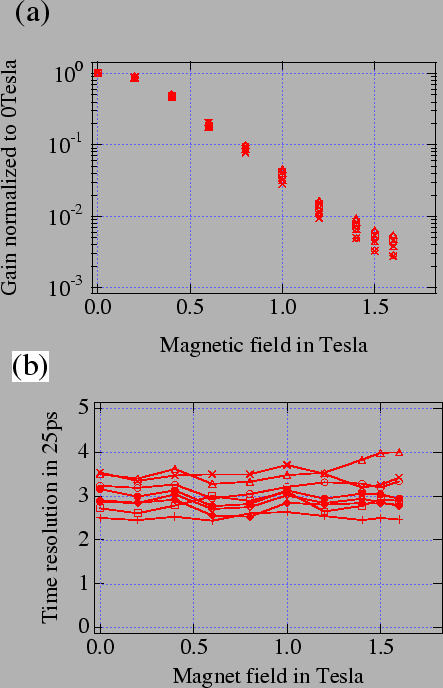



Next: Scintillators
Up: Design and Construction of
Previous: Design and Construction of
Contents
Hamamatsu (HPK) type R6680 fine-mesh photomultipliers, with a 2-inch
diameter and 24 stages of 2000 mesh/inch dynodes, have been selected
for the TOF counter. The 24 dynode stages provide a gain of
 at a high voltage below 2800 V in a magnetic field of 1.5 T.
The bialkali photocathode with an effective diameter of 39 mm covers
50 % of the end area of each TOF counter. The transit time spread is
320 ps (rms), the rise and fall times are 3.5 and 4.5 ns,
respectively, and the pulse width is about 6 ns at FWHM.
Figs.
at a high voltage below 2800 V in a magnetic field of 1.5 T.
The bialkali photocathode with an effective diameter of 39 mm covers
50 % of the end area of each TOF counter. The transit time spread is
320 ps (rms), the rise and fall times are 3.5 and 4.5 ns,
respectively, and the pulse width is about 6 ns at FWHM.
Figs. ![[*]](./icons/crossref.png) (a) and (b) show gains and time
resolutions of eight typical FM-PMTs as a function of magnetic field
strength. The measurements were performed with the field parallel to
the tube axis, using an N2-dye laser of 420 nm wavelength. Although
the gain was reduced by a factor of about 200 at 1.5 T, the time
resolution was not significantly affected. Degradation of the time
resolution of about 10 to 15 % was observed when the magnetic field
was raised from 0 to 1.5 T. All FM-PMTs were tested for their gains
and time resolutions before the final module assembly.
(a) and (b) show gains and time
resolutions of eight typical FM-PMTs as a function of magnetic field
strength. The measurements were performed with the field parallel to
the tube axis, using an N2-dye laser of 420 nm wavelength. Although
the gain was reduced by a factor of about 200 at 1.5 T, the time
resolution was not significantly affected. Degradation of the time
resolution of about 10 to 15 % was observed when the magnetic field
was raised from 0 to 1.5 T. All FM-PMTs were tested for their gains
and time resolutions before the final module assembly.
Figure:
1.5 T field test of FM-PMTs. (a) Gains and (b) time resolutions as a function of magnetic field.
 |
FM-PMTs were attached to the TOF counter ends with an air gap of
 0.1 mm. In the case of the TSC counters the tubes were glued to
the light guides at the backward ends. The air gap for the TOF counter
selectively passes earlier arrival photons and reduces a gain
saturation effect of FM-PMT due to large pulses at a very high
rate. As the time resolution is determined by the rising edge of the
time profile of arrival photons at PMT, the air gap hardly affects the
time resolution.
0.1 mm. In the case of the TSC counters the tubes were glued to
the light guides at the backward ends. The air gap for the TOF counter
selectively passes earlier arrival photons and reduces a gain
saturation effect of FM-PMT due to large pulses at a very high
rate. As the time resolution is determined by the rising edge of the
time profile of arrival photons at PMT, the air gap hardly affects the
time resolution.




Next: Scintillators
Up: Design and Construction of
Previous: Design and Construction of
Contents
Samo Stanic
2001-06-02

